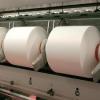 I spent a long part of my career, both operations and design in Polyester Synthetic Fiber(filament yarn and staple fiber) including operations and engineeering design. During my stint as a process design engineer involved in design of polyester plants including Polyester Filament Yarn and Polyester Staple Fiber plants one of the key requirements was finding out the the quench air requirement for cooling of molten fiber strands emerging from spinnerettes of fiber / yarn spinning machines. Normaly this data used to be provided by the spinning machine supplier. However, since the spinning machine vendor normally refused to provide backup calculations for estimating the "quench air" requirement stating that this was proprietary information it was a matter of concern. As usual, my inherent curiosity to learn about so-called proprietary information led me to a quest for finding out how quench air can be estimated. Using various article and book resources I could gather some information related to requirement of quench air for fiber quenching. These were the days when I had just got initiated and hooked upto excel calculations and decided to make a calculation spreadsheet related to estimation of "quench air based on the literature I had collected. Today's blog entry intends to provide this spreadsheet for the benefit of "Cheresources" members.
I spent a long part of my career, both operations and design in Polyester Synthetic Fiber(filament yarn and staple fiber) including operations and engineeering design. During my stint as a process design engineer involved in design of polyester plants including Polyester Filament Yarn and Polyester Staple Fiber plants one of the key requirements was finding out the the quench air requirement for cooling of molten fiber strands emerging from spinnerettes of fiber / yarn spinning machines. Normaly this data used to be provided by the spinning machine supplier. However, since the spinning machine vendor normally refused to provide backup calculations for estimating the "quench air" requirement stating that this was proprietary information it was a matter of concern. As usual, my inherent curiosity to learn about so-called proprietary information led me to a quest for finding out how quench air can be estimated. Using various article and book resources I could gather some information related to requirement of quench air for fiber quenching. These were the days when I had just got initiated and hooked upto excel calculations and decided to make a calculation spreadsheet related to estimation of "quench air based on the literature I had collected. Today's blog entry intends to provide this spreadsheet for the benefit of "Cheresources" members.I believe very few chemical / process engineers may have interest in polymers and textiles, nevertheless, those few process design engineers and operations engineers who are involved with synthetic fiber production may find it useful. Some background information is provided as a description before the excel attachment.
In quenching process, filaments are cooled from melt temperature to a temperature below the glass transition temperature. The quench air properties and system design are determined by the type of fiber produced since each has a different glass transition temperature. Spinneret shape and size, the number of filaments, spin beam configuration, the compactness of the spinning system, and amount of quench air required all bear on the quench system design.
The extruded filaments have to be cooled down below the glass transition temperature in the shortest possible distance. The extruding polymer increases in diameter above the spinneret hole size (die swell), and in turn is pulled down by the take up forces. The diameter of each filament starts getting smaller thus reducing the boundary layer and the heat transfer area. Polymer freezing occurs within few centimeters from the spinnerets. The heat is first dissipated to the boundary layer around the filament and this heat is removed by the quench air. Only a small portion of quench air participates in filament quenching. Air flowing in open spaces between the filament does not participate in the filament cooling, but it still picks up heat from the surroundings. Moreover this cold air has to be delivered to the farthest rows of filaments for efficient quenching of fibers. It is common to see the air temperature rise of about 2 to 3 0C per row of filaments.
Let me hear comments on this blog entry and the attached excel spreadsheet from the readers particularly those who are involved with the synthetic fiber industry.
The MS Excel spreadsheet to accompany this entry can be found at:
http://www.cheresour...nch-air-system/
Regards,
Ankur.

 FB
FB





great and valuable discussion.
Do you have any spreadsheet for single screw extruder calculating/design??
(power amount, L/D needed , channel depth in feeding , compression and meterign zone ,screw RPM,....)??
regards
Process-man